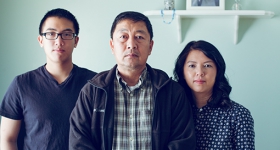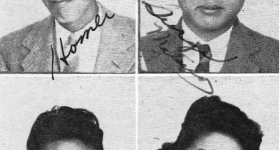ON A SATURDAY MORNING in downtown Honolulu, a small group sits practicing the traditional Hawaiian art of lauhala weaving. Over a pair of picnic tables, they are cutting and intertwining the dried leaves of the hala tree to make hats and baskets.
They call themselves “Ulana Me Ka Lokomaika‘i,” which roughly translates as “weaving with grace from within.” The name serves as a tribute of sorts to their teacher, Gladys Grace, an elderly woman of Chinese and Native Hawaiian descent.
It’s almost lunchtime, and before partaking of a generous potluck spread that includes bao, dumplings, fried chicken strips, salad and kulolo, a glutinous des- sert made out of taro plant, they stand in a circle around the food, join hands, and bow their heads. Kaia Kong, a teenage girl with a dark blonde ponytail, offers a prayer entirely in Hawaiian, except for the “amen” at the end.
Later she has some trouble putting it into English for me, glancing toward the sky as she rummages inside her head for a way to articulate her thoughts. There seems to be a deeper meaning that she is unable to vocalize.
The Hawaiian language is among many things native to the Islands that can have a bumpy translation on the mainland. The term hapa, now widely used to refer to a mixed race Asian American, is at the center of a larger de- bate about appropriation of Hawaiian words and culture that doesn’t sit well with some Native Hawaiians.
In the most basic sense, hapa means half. When Native Hawaiians and white (or haole) settlers first began producing biracial children, these offspring were referred to as being hapa haole. It’s not clear when or why, but people on the mainland, and especially in California, began applying the word to individu- als of partial Asian ancestry.
Some Native Hawaiian rights advocates say that this newer translation is not only hollow, but hewa—wrongful. In part, the reasoning goes that a mixed-blood person is not hapa unless some of that blood flows from Native Hawaiian lineage. Although not widely known, this perspective has gained traction due in part to the website www.realhapas.com.
“The misuse and misappropriation of the word hapa must end. By raping the Hawaiian language the once-colonized mixed Asians are now colonizing part of the Hawaiian language and part of the Hawaiian culture and are thus colonizing the Hawaiian people,” the website reads (its creator, who is of English, Chinese, Hawaiian and Portuguese descent, declined to be interviewed for this story).
It might be tempting to reject this perspective based on the argument that language necessarily evolves, but this is more than just a simple complaint over the usage of a single word. It represents one of the countless effects of colonialism in Hawaii and con- tradicts the popular notion proclaiming the tropical ar- chipelago to be an oasis of tranquility.
University of Hawaii Professor Huanani-Kay Trask, one of the most prominent advocates for Native Ha- waiian rights, said colonialism’s enduring legacy in the Islands has made activists like herself fiercely vigilant against further exploitation. “It has nothing to do with how
people identify,” she said about the use of the word hapa by non-Native Hawaiians. “That’s their problem, that’s not our problem. Our problem is that peo- ple come here, they take our words, they take our dress... it’s a commodi- fication, in straight capitalist terms, of somebody else’s culture."
Trask detailed a list of related grievances regarding tourists, developers, the military, the government and anyone else who profits at the ex- pense of her homeland. An outspoken leader in the Hawaiian sovereignty movement for decades, she has helped procure a permanent voice for indigenous populations at the United Nations and served as the first director of the Center for Hawaiian Studies at the University of Hawaii.
Her outrage stems from the damage done to Ha- waii and its original inhabitants. Somewhere between 300,000 to a million people lived on the Hawaiian Islands prior to the arrival of Captain James Cook in 1778. Diseases brought by seafarers and missionaries— measles, mumps, influenza, smallpox and syphilis— devastated Hawaii’s native population, which dipped to fewer than 40,000 by 1900. Those who survived to see the new century had already witnessed the imprisonment of their queen, the overthrow of their government and the annexation of their nation. Under territorial rule, traditional practices faded from use and the imposition of English pushed Hawaiian to the linguistic margins, forcing it to slowly slip from the collective memory.
Loss of life, land, language and autonomy has had lingering consequences. Today, Native Hawaiians top the state’s lists for suicide, teen pregnancy, incarceration and unemployment, among other social ills. In this bleak climate, even a borrowed word like hapa becomes a battleground.
“We’re scheduled for extinction,” Trask said, “and part of that extinction is all these non-Hawaiians run- ning around saying, ‘Yes, but that word means this to us.’ But the issue is not what it means to other people; the issue is why does everybody steal what we are? From our language, to our land base, to the definition by our own selves of who we are?”
Asian America’s adoption of hapa fits into a larger pattern, says Manu Ka‘iama, an instructor at the Cen- ter for Hawaiian Studies, who points out that “it’s another thing that we’ve had to give without wanting to— but people have taken it and run with it.”
She sees this everywhere, from cheap souvenir carvings (“most of those tikis, they represent our four major gods”), to hula (“we never wore coconut bras, that’s Hollywood”), to surfing (“we had chieftains rid- ing big surfs ... but the history books show that the first big waves were rode by Caucasian men”).
One of the biggest irritations centers around aloha, an expression of greeting with connotations of respect and affection. Trask, Ka’iama and Center for Hawaiian Studies Director John Osorio all bemoan its wanton proliferation in hokey tourist campaigns and sales pitches. “Hawaiians are very, very tired of ex- tending aloha and not having it returned,” Osorio says. “And we are equally tired of people misunderstanding that that word comes with a tremendous amount of responsibilities—co-equal responsibilities—between the giver and the recipient.”
This idea of joint responsibility also comes to bear on the word hapa. “In the context of somebody who has no connection at all with Hawaii, I just don’t see the sense of it,” Osorio says. However, he acknowledges that the unique way in which miscegenation has become accepted and even celebrated on the Islands could make a careful deployment of the word worthwhile, if “continental America is looking for a way to understand race, and to recontextualize it in ways that... make intermarriage less threatening, more acceptable.”
The 50th state’s progressive attitudes and practices regarding racial intermingling certainly does make hapa an appealing label to people of mixed ancestry in the other 49 states. Multiracial individuals across the mainland have run into widespread uneasiness and occasional hostility about what their very existence symbolizes, so to draw upon this term for the reason Osorio gives would seem very empowering—if there were no objection from a disempowered group.
Running into objections about authenticity is noth- ing new to mixed-race people seeking solidarity within minority communities. Conventionally, they encounter friction from those of their own ethnicity for lack of ra- cial purity. But in this instance, a definitive character- istic of the minority community in question is lack of racial purity. In 1960, nearly 90 percent of Native Ha- waiians were already multiracial—at a time when inter-racial marriage was still illegal in some states on the mainland. By 1970, the U.S. Census dropped the des- ignation of “full” Hawaiian as a category because there were no longer enough pureblood Natives to fill it.
Concerns over how hapa and other Hawaiian words are used may not resonate far beyond academics and activists. Other community organizations in Hawaii and the Office of Hawaiian Affairs report no uproar over how hapa is used.
Terrilee Napua Keko‘olani, co-founder of the anti-military group DMZ Hawai‘i Aloha Aina, is minimally aware of the issue: “If they don’t have [Native] blood at all and they’re us- ing hapa—that doesn’t make any sense to us.” But she shows little interest in judging others who fail to be exacting in how they use Hawaiian words.
“I misuse the language too. I’m not perfect,” Keko‘olani acknowledged, allowing that linguistic missteps are something “we gotta be cool about,” given that Hawaii has been sup- pressed for so long.
She prefers to focus on the positive. “The celebration,” Keko‘olani emphasized, “is that [Hawaiian culture is] coming back, it’s being revived.” Because of a renewed interest in Ha- waiian culture, she said, “we have 14-year-olds who speak perfect Hawaiian.”
One of these is Kaia, the girl who recited the prayer with the lauhala weavers. She’s in the eighth grade at a Hawaiian language immersion school, and when discussing her eth- nic background, she resorts to writing it down so there’s no mistake: ‘ekolu hapaha “Haole” + ‘ekahi hapaha Pake. This makes her three quarters white and one quarter Chinese.
From the casual way she approaches the subject, she doesn’t seem to assign any real significance to this identity, or the words necessary to describe it. It doesn’t seem like she cares about such things.
It’s clear what she does care about, though. Kaia says she loves her school and would like to one day pursue a career that al- lows her to advance the values and traditions of its educational mission. Her manner, which is serious but not solemn and high-minded without the slightest hint of self-importance, belies her age. I ask her why she is drawn to the Hawaiian language and what compels her to learn it.
“I think it’s beautiful—it’s like poetry,” she says. “I don’t want it to die out.”
Alec Yoshio MacDonald is an editor and writer living in Oakland, CA. He is currently seeking a new identity.









Comments